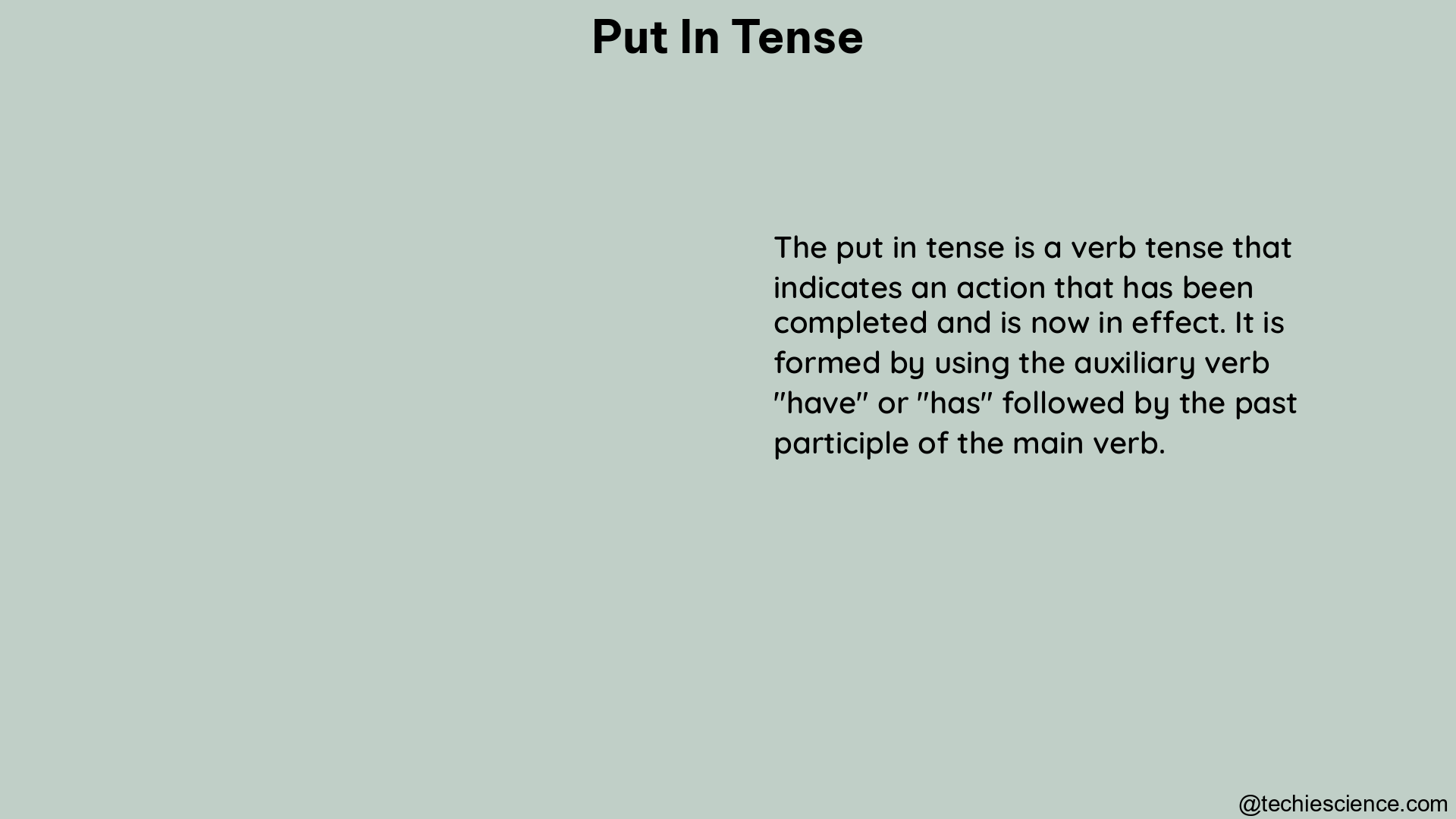The verb “put” is an irregular verb in the English language, which means it does not follow the standard pattern of adding “-ed” to form the past tense. Instead, the past tense of “put” remains the same as the present tense. Understanding the nuances of using the verb “put” in different tenses is crucial for effective communication and writing.
The Present Tense of “Put”
In the present tense, the verb “put” is conjugated as follows:
Singular:
– I put
– You put
– He/She/It puts
Plural:
– We put
– You put
– They put
Examples:
– I put the keys on the table.
– She puts the flowers in the vase every morning.
– They put the boxes in the storage room.
The Past Tense of “Put”

The past tense of “put” is the same as the present tense, which can be confusing for some learners. The conjugation is as follows:
Singular:
– I put
– You put
– He/She/It put
Plural:
– We put
– You put
– They put
Examples:
– Yesterday, I put the report on the boss’s desk.
– She put the laundry in the washing machine.
– They put the new furniture in the living room.
The Present Progressive Tense of “Put”
The present progressive tense is used to describe an action that is currently in progress. The conjugation of “put” in the present progressive tense is as follows:
Singular:
– I am putting
– You are putting
– He/She/It is putting
Plural:
– We are putting
– You are putting
– They are putting
Examples:
– I am putting the dishes in the dishwasher.
– She is putting the toys away in the closet.
– They are putting the finishing touches on the project.
The Past Progressive Tense of “Put”
The past progressive tense is used to describe an action that was in progress in the past. The conjugation of “put” in the past progressive tense is as follows:
Singular:
– I was putting
– You were putting
– He/She/It was putting
Plural:
– We were putting
– You were putting
– They were putting
Examples:
– I was putting the laundry in the dryer when the power went out.
– She was putting the books on the shelf when the earthquake struck.
– They were putting the final touches on the presentation when the meeting started.
The Present Perfect Tense of “Put”
The present perfect tense is used to describe an action that has been completed in the past, but the effects are still relevant in the present. The conjugation of “put” in the present perfect tense is as follows:
Singular:
– I have put
– You have put
– He/She/It has put
Plural:
– We have put
– You have put
– They have put
Examples:
– I have put the report in the file cabinet.
– She has put the children to bed.
– They have put up the new shelves in the office.
The Past Perfect Tense of “Put”
The past perfect tense is used to describe an action that was completed before another past action or event. The conjugation of “put” in the past perfect tense is as follows:
Singular:
– I had put
– You had put
– He/She/It had put
Plural:
– We had put
– You had put
– They had put
Examples:
– I had put the groceries away before the guests arrived.
– She had put the finishing touches on the project before the deadline.
– They had put the new furniture in the house before the move-in date.
The Future Tense of “Put”
The future tense is used to describe an action that will occur in the future. The conjugation of “put” in the future tense is as follows:
Singular:
– I will put
– You will put
– He/She/It will put
Plural:
– We will put
– You will put
– They will put
Examples:
– I will put the report on the boss’s desk tomorrow.
– She will put the children to bed early tonight.
– They will put the new furniture in the living room next week.
The Future Progressive Tense of “Put”
The future progressive tense is used to describe an action that will be in progress in the future. The conjugation of “put” in the future progressive tense is as follows:
Singular:
– I will be putting
– You will be putting
– He/She/It will be putting
Plural:
– We will be putting
– You will be putting
– They will be putting
Examples:
– I will be putting the finishing touches on the project tomorrow.
– She will be putting the children to bed when you arrive.
– They will be putting the new furniture in the living room all day.
The Future Perfect Tense of “Put”
The future perfect tense is used to describe an action that will be completed by a certain point in the future. The conjugation of “put” in the future perfect tense is as follows:
Singular:
– I will have put
– You will have put
– He/She/It will have put
Plural:
– We will have put
– You will have put
– They will have put
Examples:
– I will have put the report on the boss’s desk by the end of the day.
– She will have put the children to bed by the time you get home.
– They will have put the new furniture in the living room before the party.
The Future Perfect Progressive Tense of “Put”
The future perfect progressive tense is used to describe an action that will be in progress and completed by a certain point in the future. The conjugation of “put” in the future perfect progressive tense is as follows:
Singular:
– I will have been putting
– You will have been putting
– He/She/It will have been putting
Plural:
– We will have been putting
– You will have been putting
– They will have been putting
Examples:
– I will have been putting the finishing touches on the project by the time the deadline arrives.
– She will have been putting the children to bed for an hour by the time you get home.
– They will have been putting the new furniture in the living room all day by the time the party starts.
Conclusion
The verb “put” is an irregular verb in the English language, which means it does not follow the standard pattern of adding “-ed” to form the past tense. Understanding the nuances of using the verb “put” in different tenses is crucial for effective communication and writing. This comprehensive guide has provided a detailed overview of the conjugation and usage of the verb “put” in various tenses, including examples to help reinforce the concepts.
References
- https://preply.com/en/question/simple-past-tense-of-put-52054
- https://www.writingenglish.com/cverbs/put.htm
- https://dictionary.cambridge.org/us/grammar/british-grammar/put

Hi…. I am Goutam Datta. I have completed a double M. A. in English and B. Ed. I am a creative writer. Currently, I am a part of the LambdaGeeks.